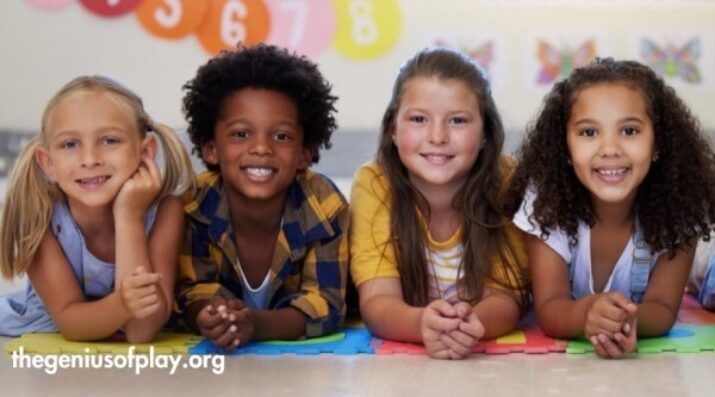Designing for Equity
How to Nurture Diverse and Inclusive Classrooms through Play
Topics

Together, educators are doing the reimagining and reinvention work necessary to make true educational equity possible. Student-centered learning advances equity when it values social and emotional growth alongside academic achievement, takes a cultural lens on strengths and competencies, and equips students with the power and skills to address injustice in their schools and communities.
By infusing play into teaching, educators can create an interactive environment where students of all ages can approach complex topics with enthusiasm, adventure, and a sense of curiosity while achieving educational goals.
By using play to explore and celebrate diversity, educators can foster a more inclusive and accepting community among students, allowing for a safe space for student-led discussions about their understanding and experiences with these complex topics. The more we embrace and celebrate our differences, the more we learn how much we truly have in common.
This article explores various play methods for educators to teach children about diversity and inclusion, providing meaningful suggestions as well as steps for educators, children, and families to make a lasting impact in their community. Additionally, real-world examples and the power of using play as a tool for navigating complex topics are discussed, promoting interactive and engaging learning experiences for students of all ages.
What is the appropriate age for kids to start learning about race? How do you recommend educators approach the subject?
Children are incredibly perceptive and notice differences in people as early as preschool, making it a wonderful time for children to start learning about race. Educators can approach this subject with playfulness by using diverse toys, books, and activities that celebrate various cultures, especially relating to children’s unique backgrounds. Natural resources and tools spur connections for children as they listen to stories, engage in lessons, and participate in activities, creating confidence and purpose in their work. It’s important to create a welcoming environment where all questions are encouraged, which will grow the conversation as educators instill the value of diversity, kindness, and empathy to foster a sense of inclusion and understanding from an early age.
Beyond conversation, what are some steps educators can take to have a real impact in their local communities, further teaching children about diversity and inclusion?
To have a real impact in local communities and further teach children about diversity and inclusion, educators can take proactive steps by ensuring children engage with peers from different racial, religious, and ability backgrounds. Attending local trips to various play spaces, such as parks, museums, and community centers where diversity is evident and normalized helps children understand and appreciate the differences within their communities. Additionally, educators can support children’s participation in activities like sports, art, and music that celebrate multiculturalism and diversity.
Educators can also inspire community engagement by motivating families to enhance their local communities through volunteering at local cultural and inclusive events. Using online resources or visiting local libraries allows educators and families to learn about upcoming events that promote diversity and inclusion throughout local neighborhoods. Educators can also send home flyers and monthly calendars with highlighted events. After various activities and events occur, educators can facilitate discussions with children, encouraging them to share their discoveries along with their most enjoyable experiences. Real-world, active engagement with community members helps children learn about and embrace the richness of diversity in a more tangible and lasting way.
What are some effective methods that educators can implement in the classroom to teach children about diversity and inclusion?
Continued incorporation of lessons and activities surrounding diversity and inclusion into a child's curriculum is key to success. Approaches should be integrated consistently and through natural means, such as storytelling and discussions. Educators can introduce children to diverse perspectives and experiences through age-appropriate books, videos, and personal stories that highlight different cultures, backgrounds, and life experiences. Following the stories, open discussions can be facilitated where children are encouraged to share their thoughts, ask questions, and express their feelings, which inspires open-ended dialogue and helps children understand the richness and value of diversity.
Collaborative learning allows children to interact with peers who may have different perspectives, experiences, and abilities. Children should have the opportunity to work with their peers as each student brings their own cultural knowledge and experience to every lesson, fostering an environment where diversity is celebrated, and inclusion is actively practiced. Educators can structure group activities to encourage empathy, communication, and cooperation among students, assisting in everyone’s unique contributions so every student feels valued and respected.
Celebrating differences is a fundamental aspect of promoting inclusion. As role models, educators play a pivotal part in modeling inclusive behavior and language for their students. Demonstrating respect for diversity in interactions and encouraging students to follow suit can be a powerful teaching tool. Educators should acknowledge and value the unique qualities and strengths of each child, emphasizing that their differences are assets to the classroom community which fosters acceptance, empathy, awareness, and the benefits of community building.
Can you share examples of play activities educators can do with their students to foster an appreciation and respect for people of different genders, races, cultures, abilities, etc.?
By using play to explore and celebrate diversity, educators can cultivate a more inclusive, accepting, and empathetic community, creating a comfortable space for student-led discussions. Play activities can be powerful tools for educators to align lessons while promoting acceptance and community throughout classrooms and schools, as students engage in fun, meaningful ways.
Here are some examples of play activities to promote appreciation and respect for diversity and inclusion:
- Cultural Show-and-Tell: Encourage students to bring in an item, recipe, or story from their own culture or heritage. They can share these with their peers, helping everyone learn about and appreciate the richness of different cultures.
- Multicultural Storytelling: Share stories from various cultures and backgrounds. Afterward, have students create their own stories that reflect diverse characters and settings, while also sharing thoughts about prejudices or moments of cultural celebration. This can promote understanding, empathy, and respect for individual experiences.
- Diversity Games: Incorporate games with different aspects of diversity, such as various cultural symbols, gender pronouns, or famous people from different backgrounds. Games can be simple modifications to current games such as Bingo or scavenger hunts, or entirely new games that the students help invent.
- Art and Craft Projects: Engage students in art and craft projects celebrating diversity and inclusion. For example, they can create a collaborative mural or collage featuring elements from different cultures or make friendship bracelets that symbolize unity and camaraderie.
- Cultural Days: Designate specific days to celebrate different cultures in your classroom. Each day can focus on learning about a particular culture's history, traditions, and contributions including local foods for tasting and native music for dance exploration.
How can we use play as a springboard for navigating complex topics, especially with older students?
Utilizing play as an educational tool effectively engages students in exploring complex subjects through meaningful ways. Incorporating gamification lessons makes learning interactive and fun, promoting problem-solving, critical thinking, and strategic decision-making, while also creating a safe and comfortable environment for learning and discussions to flourish. Educators can facilitate creative projects enriched with multimodal elements like collage, sculpture, painting, and writing, which allows students to express their understanding of complex issues such as race, activism, disability laws, and so forth in an expressive manner.
Collaborating with other educators within the school who focus on drama, technology, or physical education provides multiple ways to captivate students and facilitate an array of different perspectives about diversity and inclusion, while also allowing all educators to feel comfortable teaching about these complex topics. By infusing play into teaching, educators can create an interactive environment where students of all ages can approach complex topics with enthusiasm, adventure, and a sense of curiosity while achieving educational goals.
Image at top courtesy of The Genius of Play. This article originally appeared on The Genius of Play website.




